Blog ~~ Piedmont Division

Welcome to the Piedmont Blog!
By Ryan Boudreaux
NEWS ALERT! Piedmont Division ~ Blog is now on a new page. The page you are on will stay on the site but will be moved to the sub-menu link. Please check out the new PD ~ Blog!
Purchasing items for my layout....Oh My!
July 3, 2007
After arriving home from work yesterday I found the Walthers July sale catalog in the mail stack, and with sale prices good through August 31, 2007. Oh boy, I was excited to see what items were on sale this time around. After sorting all the mail I put the catalog into my work bag and forgot all about it.
At lunch today I pulled out my reading material and found the Walthers July sale catalog nestled safely between the August 07' Model Railroader magazine and another periodical. I breezed through the catalog and saw a few items of interest and made a few mental notes about some of them as I continued to turn the pages. After flipping through the whole flyer sized sale catalog I decided to pull out my post it notes and write down a few things.
Post it note #1: Decoder and sound decoder available for this item?
And then I neatly stuck the post it note on the top of page 46 to remind me of the ALCO RS-2 priced at $99.98 each. I like the Southern road name, two of those would be a great addition to my Piedmont Division layout. It lists a DCC-friendly mechanism with clip-fit circuit board. I wonder what that means. Opps, then I went back again and noticed that this was an ad for N scale locomotives, oh well, I need HO. So I took the post it note, crumpled it up and threw it away.
As I was flipping back through and on page 22 I noticed the Gold Line Evans 100-ton 55' Cushion Coil Cars for $36.98 for a limited-run 2-pack.
Post it note #2: Get a quote on #932-23845
I am sure Train Buddy could get me a better deal than the advertised price of $36.98! So, the post it note will remind me to make the call or send an email to Kim Parker for the 20% +/- discount.
Continuing with flipping the pages I started looking at the structures on page 31 and saw the Street System Arched Road Bridge Kit for $24.98. Wow, that looked great for modeling an arched bridge over a road. But it is made for road street systems, I wonder if it could be used with roadbed and track over the top section?
Post it note #3: Can RR roadbed & track work here? #933-3196
Another question for Kim at Train Buddy....
Flipped the page again and started eyeing all the great HO scale structures on pages 32 and 33. I thought the interlocking tower (933-2837) would be a great model to have near my classification yard. But then I thought is this model prototypical of Southern Railroad architecture? Would it fit on my layout? Would it be realistically in use on my modern Norfolk Southern layout today?
Then I remembered how I used to buy HO scale stuff without a thought to how it would fit in with the layout, not even a glimmer of what I was going to do with it! I just knew I had to have it. Now when I see anything to do with HO and the Southern or Norfolk Southern railroad I put a little thought into if it is going to fit into the layout.
I also believe that in the early stages of getting into this hobby I had no clear direction of what I was going to do, I just knew I wanted to start collecting stuff like rolling stock, locomotives, structures, etc.
Now that I am a bit wiser I have to stop and think about how this new item will fit into the layout, or if this is a prototypically correct version that will fit in with my layout, era, road names, and location.
I also thought that suppliers such as Walthers plays into the notion of "...just buy this stuff now and figure it out later" mentality. I know that they have improved their descriptions on many items in providing a short background on the prototype usages of rolling stock, locos, and structures. But it seems like the marketing side can overwhelm you in the beginning and puts you in that "I just have to have it" mode.
I almost got caught up in the "have to have it" mode just now, but after pulling the reigns back I realized that in my attempt to stay true to the prototype it has also kept the hole in my pocket from getting too much bigger!
Cheers,
Ryan
In search of the prototype - a basis for modeling!
Originally posted on Friday, April 27, 2007
The last time I visited my local train shop I recall a conversation with Kim parker, he is the owner of Train Buddy Train Shop just off of Jenkins Road in Wake Forest, North Carolina Train Buddy (http://www.trainbuddy.com). We were mulling over the prototype operations of the Southern Railway and their use of whistle sign posts along the right of way, and then this led to a discussion of how this could be incorporated into model train operations on the layout. The discussion ended where we both agreed that there is a certain give and take when it comes to creating an accurate model of the prototype or applying real railroad operations to modeling operations.(see Image 1)i.
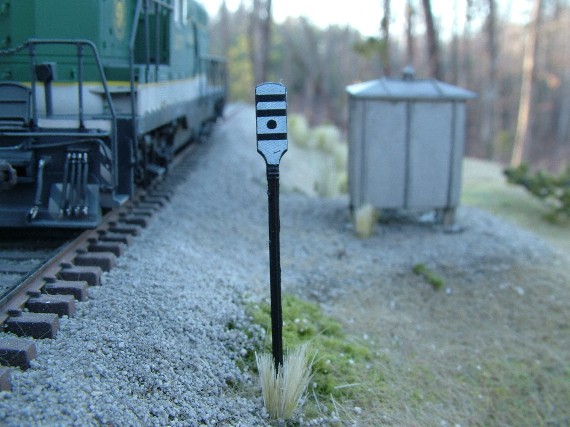
I wanted to research more about the prototype of the Southern Railway operations, so I went hunting. The more I found the more I wanted to find, so I became enthralled with the assignment. I want to share with you what I have learned about transforming a prototype real world railroad into a real world model railroad layout. While my personal research primarily focuses on the history of the Southern Railway, Norfolk Southern, and Norfolk and Western railroads, this article will touch on varied aspects of many others as well. I will also reference many sources, and primarily those from web sites that provide relevant information that supports research on the subject. In doing so, I will also utilize sources that are not always traditional in most model railroading or railroading related articles. For example, one of my resources is from a dynamic IT web site that happened to have a "Picture of the Day" posted an image of straight railroad tracks. In that vein and by the very nature, when a URL is available it will be provided in hypertext link format and the date it was accessed for this research will also be noted in the reference section. Web sites are changed, updated, or moved often, so the availability of these links cannot be guaranteed, however, they were valid at the dates specified in the reference.
Did I hear you say?
Walk into any train shop and the one word that is invariably guaranteed to pop up in most conversations is that ubiquitous declaration - prototype. This utterance can be found in simple yet heartily phrased statements such as (in a deep vocal tone) "...and when modeling the prototype you must consider...", or "Prototype operations are the foundation of solid modeling...", or "The prototype is your starting point for creating an accurate model of...", and so on.
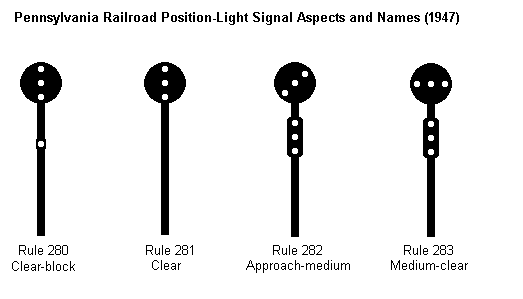
Early on in my modeling goings-on I had a fear of the prototype, and I think most beginning modelers feel the same way, I reached a point where too much information became more than I could handle. For some modelers this fear becomes a stumbling block for further progression in the hobby, and for others they just throw up their hands in disgust and give up trying. Some modelers resolve within themselves to find a happy medium and do not get too concerned or caught up with modeling the prototype in form, function, or operations. I mean what the heck does Rule 281 mean and why do I need to know that? I can stop and start my model trains anytime I dam well please right! Okay, for those who don't know, Rule 218 as specified by the Pennsylvania Railroad in 1947 is stated in the following text: Clear: Proceed. The signal is displayed at the entrance of an interlocking or automatic block, or by a distant signal protecting an isolated facing-point switch. (See Figure 1.)ii.
I reached a point where I overcame the initial fear and began studying more about what the real world railroad does, I started asking questions like how does the railroad get their work done, and how do these trains go from point A to point B? Like me, many modelers continue to persevere and set in motion a long climb to conquer the summit known as the prototype. We study it, we learn about it, we research it, we dig up information about it, we travel long distances to find locations with current activity (AKA rail fanning), and we take many pictures along the way. And then somewhere along the way in the recesses of our mind it all starts to click and make sense. The once felt fear of the unknown turns into a fever, and I am not talking about a sickness, but a passion, a passion to discover more about this ever elusive archetype known as the prototype. So what is this mysterious prototype and where did it come from?
What is a prototype?
Let's start with the text book definition of the word as found from Merriam-Webster OnLine Dictionary:iii.
So, from the official definition a prototype is the original standard and typical example that exhibits the essential features that make up the full-scale 1:1 functional object. According to Ron Hildebrand of the Proto 87 Chroniclesiv. web site:
Ron really makes sense to me in his statement that it is more of a state of mind than it is a standard defining a specific prototype to modeling direct method. His example of a modeler putting certain decals on a certain box car are visually fitting and are a good anchor for narrowing the scope on what it means to model in a prototypical fashion. He also touches on a "hot" topic that I will mention later.

Where can I find the prototype?
Just look in your back yard! Well, maybe not "your" back yard, but I bet if you drive around the streets in your neck of the woods for 30 minutes or so you will eventually come across a railroad track. I see examples of the prototype everyday and wonder how these can be modeled in an accurate representation, only in a smaller space. I will be driving to or from work and start noticing things along the way, like a rock cut, or a grassy field, or the way a certain tree has fallen into the edge of Falls Lake, or the Norfolk Southern railroad bridge over T.W. Alexander Road. And then I start to wonder how I would model that scene, tree, structure, bridge, or grassy field on my layout. I find myself always thinking of how an aspect of the real world can be applied to the model railroad layout.
Since I model HO which has a ratio of 1:87.1 to the prototype, factors must be taken into account when space limitations are considered. For example, it would be totally impossible for me to model the nation's longest straight stretch of track, the CSX line between Laurel Hill and Acme in North Carolina, where the grade does not stray of course for 78 miles.v.
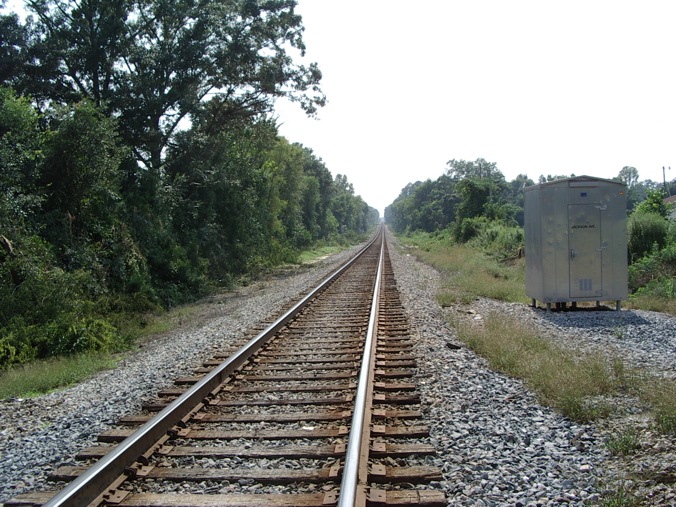
Stand at the grade crossing along the route in the small town of Maxton, NC and the headlight of the oncoming train is visible for several minutes before it comes near (See image 2)vi.. Out of just pure speculation and modeling interest, let's say I wanted to accurately model a full 78 mile stretch of straight track on an HO scale layout, how could I make that happen? Modeling this 78 miles stretch in HO would take approximately 4,728 feet, or just over 1,576 yards. To house this straight stretch of HO track in detailed and completely accurate prototype fashion would take a building that would be at least 16 football fields lined up end to end. Heck, a mile is 5,280 feet, so this building would have to be almost a mile long. I feel for the person who has to sweep that floor. And think of how much maintenance those modeled tracks would be, not to mention the cost factor. Just for fun, I worked up figures for the straight track portion of the modeled 78 mile stretch on the layout and depicted accurately in HO would cost about $4,570.75 + tax at today's prices, and this is for 3 foot sections of Atlas code 83 flex track. Not exactly what I had in mind when modeling the prototype. I am only trying to make a point here, and that is when modeling the prototype you have to know where you can fudge a little and where you want to approximate the prototype.
How do you model a prototype accurately?
There is no one-way to model a prototype and the variations are many. However, there are some techniques that have been identified and are in common use today that assist the modeler in representing an accurate model of the prototype. As stated earlier, it would be impossible and unrealistic to model a 78 mile stretch of straight track in any model train scale. So how do you go about approaching an accurate representation of a prototype railroad?
Compression, isn't that how diamonds are made?
Let's review one of the popular modeling techniques utilized today, selective compression. I hear this phrase a lot these days, especially in the online forums, magazines, books, and the Internet all have references to it, and so what's the big deal with selective compression?. What am I selecting and compressing it into what? Is it like a trash compactor, putting more stuff into a tightly bound bag and hoping for the best? Or when you compress this stuff, does it turn into something else? Like carbon pressed into a diamond! Sort of! I ask a lot of questions, I know, so let's pry a few rocks back to find the answers together. Get out your rock hammers and your picks, and let's start some real digging!
Part II - In search of the prototype - a basis for modeling!
Originally posted on Monday, April 30, 2007
Since you are online now, open up a new Internet browser window and using your favorite search engine type in the phrase "selective compression". Be sure to use the quotes too just like I did in Google. And at first glance we come up with results that don't even come close to what I was looking for, references to video file compression, PHP web authoring techniques, and technical stuff like that. So, let's do another search, but change the search criteria to "selective compression" and add the word modeling.vii.

And voila, I get some search results that look more like what I was hoping to find. Such as Selective Compression -Will it work?, or The Proto:87 Chronicles / The Concept, more like it! The March 2007 issue of Railroad Model Craftsman has an article that describes how to employ the selective compression process when modeling large structures. It is entitled "Scratchbuilder's corner: Large projects" by Bob Walker, and found starting on page 70viii.. The National Model Railroad Association (NMRA) in their Achievement Program Master Builder - Prototype Models qualifications includes the following statement in part 2. B. Structures (35 pts): "Selective compression is acceptable as long as the character of the original is preserved (modeling a six-door prototype freight house as having only four doors to save space, for example). If you are in doubt, consult your local or regional AP Manager."ix.
Space limitations are a reality, and we all have them, so we best find a way to deal with the situation and move onto how to get err done. Enter selective compression. The whole theory of selective compression means that we are willing to give up or compromise the prototype to fit the available space. As modelers we have to decide what we are willing to compromise, and then we have to figure out the best way to represent the concessions on the layout, and try to preserve the spirit of the prototype. Easy enough right? Not quite!
There are a few techniques and tools that have been perfected by others that address the very issue of representing the prototype on the layout. Does the phrase "Layout Design Element" (LDE) ring a bell? In the 1995 issue of Model Railroad Planning published by Kalmbach Publishing, Tony Koester describes the Layout Design Element as
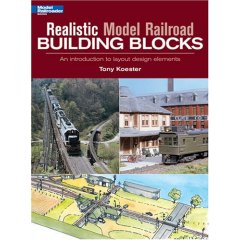
In his article, Tony describes how to employ the LDE basic concept and further explains that even the rank beginner can do a better job of layout design when using this method. The LDE takes a specific defined area and scales it to fit within a small area, then with various LDE's tied together will make up the whole of the layout. Using prototypical track arrangements, then applying them to the layout in LDE format, and when put together should create a single track plan that makes sense - prototypically of course. An introductory article on LDE's can be found on the Model Railroader Magazine Trains.com website.xi.
Tony and Kalmback also went on to publish in December 2005 the book entitled Realistic Model Railroad Building Blocks: An Introduction To Layout Design Elements as a part of the Model Railroader book series and it is in paperback format.
If you go to the Amazon.com xii. web site and run a search for this book there are a few interesting reviews. One reviewer John A Lee, III "jal3" from San Antonio, TX gave the book 3 stars out of a possible 5, and he was not too happy with the overall approach that Tony took with the content. Mr. Lee stated,
The reviewer was looking for something more specific in the small building blocks approach, or more like a quick fix if you ask me. Sometimes we are searching for that quick answer or for a quick fix, and guess what folks, most of the time the answers are not right out there in plain view. My intention is not to bash the reviewer here, but to point out the very panacea that most of us are looking for does not come in a one size fits all solution. Now in my estimation a "design philosophy" is really a "state of mind", and therefore is different for everyone. What works for you and your modeling techniques should work for others, but we also know that there is more than one way to skin a cat too.
Take a basic recipe or formula for let's say a weathering dusting powder mix for a charcoal grey color, and it looks great on those trestle bents. Now, add a bit more powdered burnt umber and you have a whole new color. Recipes, formulas, directions, plans, blueprints - they are all a form of guidelines. Now in some specific cases a formula is a very specific set of ingredients, instructions, and procedures and if changed it becomes something else, or worse, a botched attempt, especially in chemical compositions. But I am talking about model trains here, with more room for fudge factor. Have you found your diamond in the rough yet? I'm getting there, but still lurking!
Making the Best of an Imperfect Situation
Since I am modeling the Piedmont Division of the Norfolk Southern Railroad, I will use this prototype as an example of how I processed the selection for my model railroad layout. First, a little history on how my current layout plan has evolved and changed, its current iteration is actually an orphan of a previous layout plan that I originally began designing in December of 2004. So, step into the wayback machine with me for a few minutes.
The original plan was based on the Southern, Norfolk Southern, and Kansas City Southern Railroads as they operated in Southeast Louisiana, specifically the areas between Lafayette and New Orleans, Louisiana. In New Orleans where we lived at the time, the train room was all built out with new flooring and renovations were completed in July of 2005, and the room was ready for the beginnings of the benchwork building stage..and then along came my friend Katrina. Consequently August 29, 2005 will always be remembered as a blessing in disguise for me and my family, but that whole tale makes for another human interest story to be told else ware. After the dust settled from our move to North Carolina in January of 2006, I started drawing revised plans again for the new train room in March of 2006.
As a result, I wanted to model the Piedmont Division of the Southern Railway and Norfolk Southern Railroad. The entire Piedmont Division as it exists today covers over 1,579 miles of track and right of way.xiii. The northern most terminus of the Piedmont Division is in Washington, DC, and the southern most tracks end in Norcross, GA. The division also traverses to the easternmost track ending in Morehead City, NC. The entire division covers four states and the District of Columbia along the eastern seaboard region of the United States, including DC, Virginia, North Carolina, South Carolina, and Georgia. Can I model this division accurately in a prototypical fashion and under one roof? Realistically it would be impossible to model the entire division; however, literally it can happen with selective compression. I would be great if we could model trains without having to make compromises due to space limitations. But in the real world we are limited only by our imagination, space, and monetary means.
The Piedmont Division is sub-divided into districts, each district represents a specific area served within the region, and currently there are 7 districts that make up the area. I decided to stick with modeling the western and central region of North Carolina since geographically I currently live in this locality and it would be easy for me to research the prototype since I can see portions of it every day. Specifically I narrowed even further the scope of my prototype and now I am modeling the track rights between Asheville, NC and Raleigh, NC, and on the map this length of track is approximately 251 miles.
Southern Railway Serves the South - Visiting the Prototype
Originally posted on Tuesday, May 22, 2007
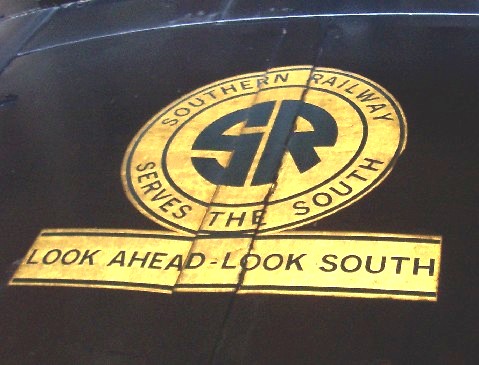
Southern Railway Serves the South was one of the many slogans of the Southern Railway, and this slogan was initially filed with the United States Patent and Trademark Office (USPTO) on July 12, 1947 and officially registered on January 4, 1949. This listing can be found on the website of the USTPO Trademark Applications and Registrations Retrieval (TARR).xiv
Currently the Norfolk Southern Railway Company owns the trademark slogan, and renewed the application a third time for a 10 year period that began on August 4, 1999. The image of the slogan and logo was taken from the back side of the Southern derrick maintenance of way car #903006 that is currently on display inside the Robert Julian Roundhouse at the North Carolina Transportation Museum (NCTHC) which is located in Spencer, NC. The current museum sits on the original site of the old Southern Railway Spencer Locomotive Shops.
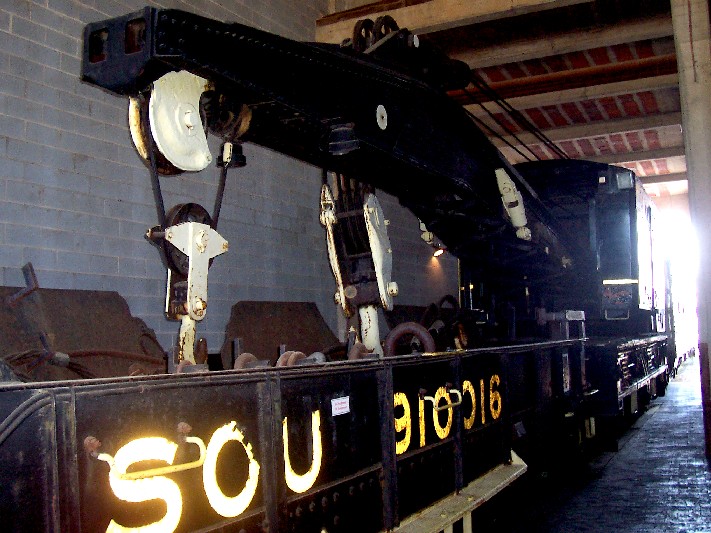
This 150-ton derrick was built by the Bucyrus Company of Milwaukee, WI in 1921 as steam-powered. The Southern did not convert their derricks to diesel until the 1970s. This derrick was assigned to New Orleans, LA. Work trains had derricks to re-rail freight cars and locomotives. Norfolk Southern Corporation donated the derrick to NCTHC in 1990.xv
These images were taken on our way back from a short vacation in the Smoky Mountains in Tennessee and western North Carolina. I convinced the family that the short 30 minute drive and diversion from Interstate 40 would get us a few hours of visiting a really neat museum. And boy was I delighted! As we entered the Barber Junction depot information station of the NCTHC to buy our tickets for the short train ride I noticed a small sign next to the register advertising cab rides for $10.00 per person. Now my excitement level jumped about tenfold! After purchasing the three tickets we waited about 25 minutes and then were able to climb up and into the cab of the Southern #6133 FP-7 locomotive. Monique and Ben sat in the extra seats and I stood up for the enjoyable 25 minute ride through the grounds with Paul the Engineer. The grounds cover approximately 44 acres of the original site and both ends of the yard tracks are still connected to the Norfolk Southern line between Salisbury and Spencer, NC.

Southern Railway #6133--- The locomotive was built by the Electro-Motive Division of General Motors in 1950. This FP-7, operated by the Southern Railway, was the property of the CNO&TP (Cincinnati, New Orleans & Texas Pacific). The FP designation meant the locomotive could be used for passenger or freight trains, using a 567-B 16 cylinder prime mover, generating 1600 horsepower. These were F-7 freight locomotives with a steam generator placed at the rear of the locomotive, increasing body length by four feet. FP-7 locomotives were used on small branch-line passenger trains throughout the Southern Railway System. By the late 1970s, there were very few FP-7s left on the roster due to Southern eliminating many passenger trains. The 5-8 left were used for excursion trains as part of the Steam Program begun in 1966. The 6133 was donated to the NCTHC in 1980, and restored by the volunteers to its original green/ imitation aluminum paint scheme. It is used to pull the train ride around the property when needed. Another mechanical and paint restoration was performed by the Ohio Central Railroad in 2006. xvi
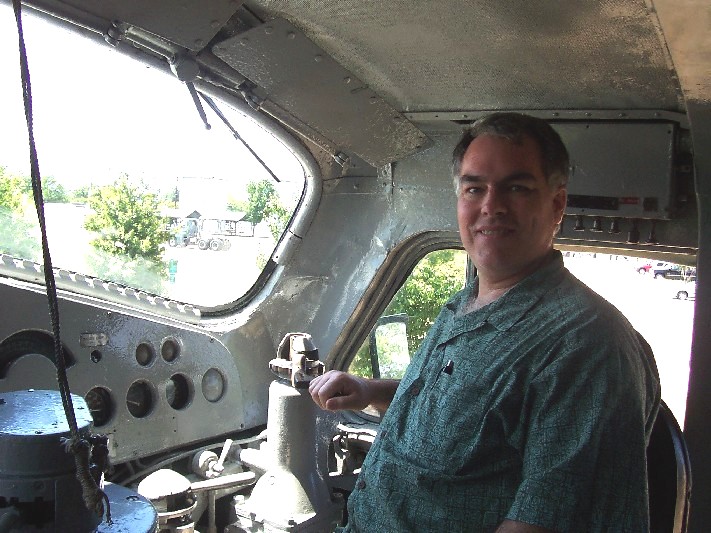
The ride consisted of an initial backup maneuver out of the station and past the switch, then forward travel north through the facility and up to the north end of the yard limit. The track switches utilize spring loaded throws that facilitate backing out of the passenger station lead and into the outside track. Once the train passes another spring loaded switch at the north end of the yard lead it backs up again and follows an inside track that takes it back to the passenger station. Once back to the station engineer Paul allowed us to tour the engine room of the FP-7, and it was quite hot in there. The head is also located at the back of the engine room, and makes for quite a noisy and hot relief; luckily we did not need to use the facilities.
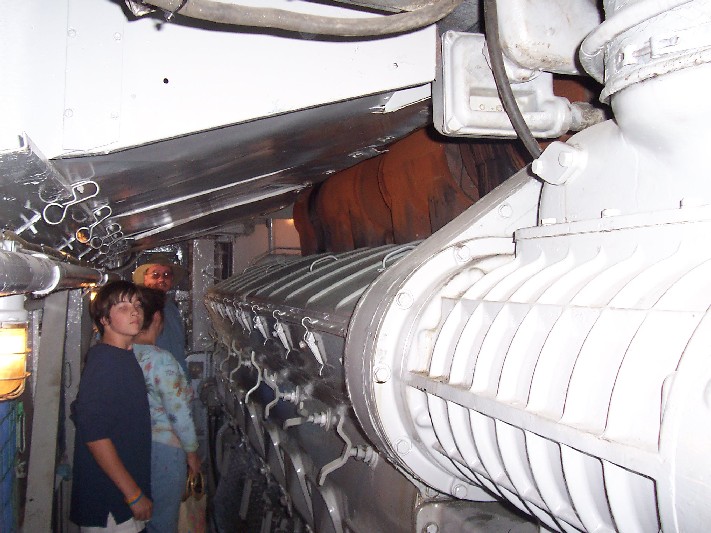
Reference
i. Wright Track Models - In The Yard - web site, from the URL: http://www.wrighttrak.com/intheyard.html, April 12, 2007.
ii. Railway History and Engineering, Especially Signaling and Operation, PRR Position-Light Signal Aspects, - web site, from the URL: http://www.du.edu/~jcalvert/railway/prraspec.htm, April 12, 2007
iii. Merriam-Webster's OnLine Dictionary web site, from the URL: http://www.m-w.com/dictionary/prototype, April 12, 2007.
iv. The Proto 87 Chronicles - web site, from the URL: http://www.theproto87chronicles.com/index2.html, April 12, 2007.
v. Carolina Railroad Top 10 List - web site, from the URL: http://www.tarheelpress.com/Top10.html , April 13, 2007.
vi. Railroad Tracks image, Picture of the Day from the web site URL: http://www.attention-to-details.com/newslog/38a-avoiding-lasik-problems-with-corneal.asp , April 12, 2007
vii. Google Search web site entry, from the URL: http://www.google.com, April 12, 2007.
viii. Railroad Model Craftsman - web site, from the URL: http://www.rrmodelcraftsman.com/this.html, April 12, 2007.
ix. National Model Railroad Association - web site, from the URL: http://www.nmra.org/achievement/apc4a.html, April 12, 2007.
x. Layout Design 2000 - web site, from the URL: http://www.trackplanning.com/LD2000.htm, April 12, 2007
xi. Model Railroader Magazine - web site, from the URL: http://www.trains.com/mrr/default.aspx?c=a&id=264 April 12, 2007.
xii. Amazon.com - web site, URL: http://www.amazon.com, April 13, 2007.
xiii. Norfolk Southern, Piedmont Division Timetable No. 19, Sunday, June 20, 1999.
xiv. United States Patent and Trademark Office - Trademark Applications and Registrations Retrieval (TARR) http://tarr.uspto.gov/servlet/tarr?regser=registration&entry=0505509&action=Request+Status
xv. INTERPRETIVE ROSTER OF RAIL EQUIPMENT NORTH CAROLINA TRANSPORTATION MUSEUM, NCTM_RailEquipment.pdf , page 12
xvi. INTERPRETIVE ROSTER OF RAIL EQUIPMENT NORTH CAROLINA TRANSPORTATION MUSEUM, NCTM_RailEquipment.pdf , pages 3 & 4









